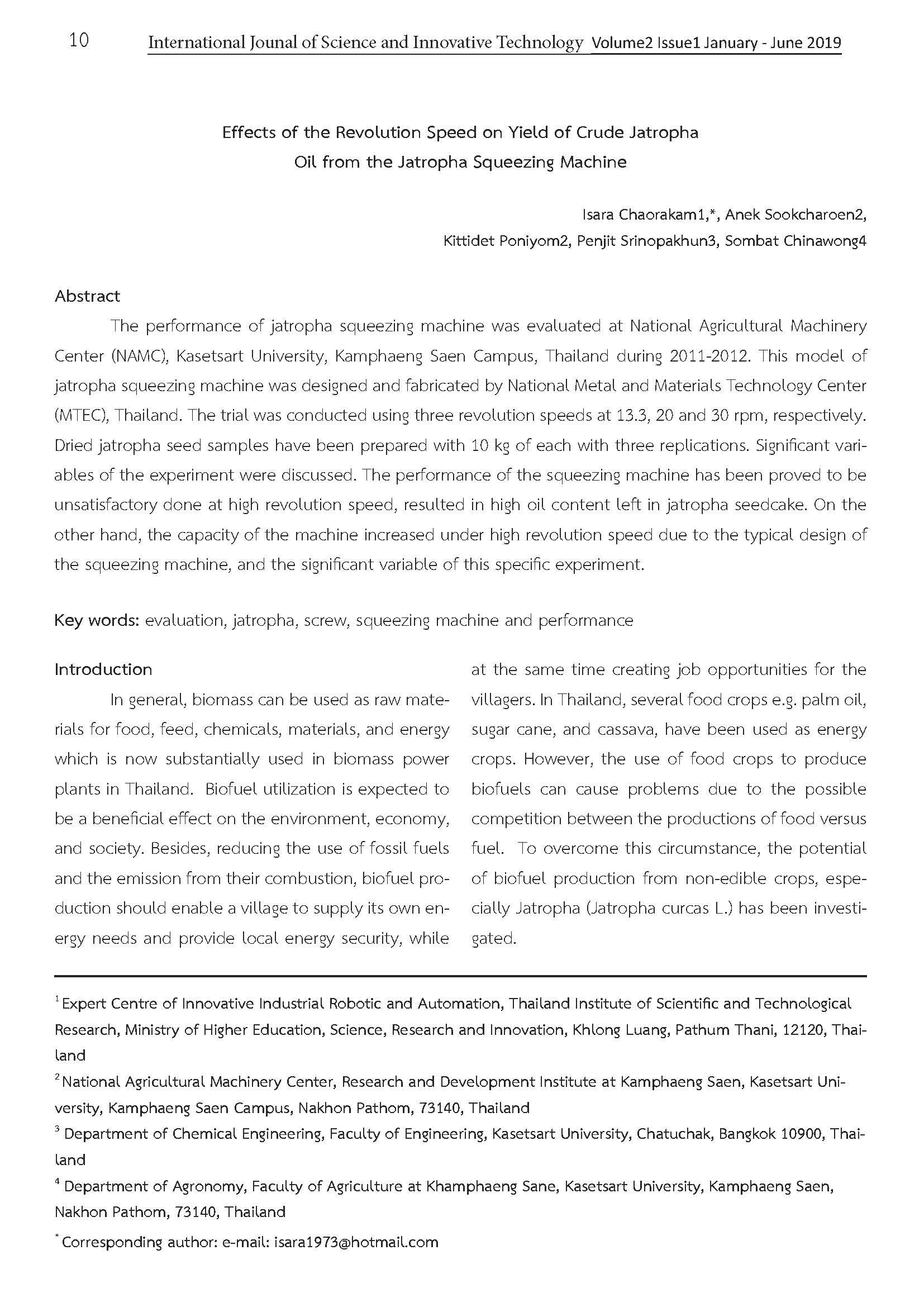Effects of the Revolution Speed on Yield of Crude Jatropha Oil from the Jatropha Squeezing Machine
Main Article Content
Abstract
The performance of jatropha squeezing machine was evaluated at National Agricultural Machinery Center (NAMC), Kasetsart University, Kamphaeng Saen Campus, Thailand during 2011-2012. This model of jatropha squeezing machine was designed and fabricated by National Metal and Materials Technology Center (MTEC), Thailand. The trial was conducted using three revolution speeds at 13.3, 20 and 30 rpm, respectively. Dried jatropha seed samples have been prepared with 10 kg of each with three replications. Significant variables of the experiment were discussed. The performance of the squeezing machine has been proved to be unsatisfactory done at high revolution speed, resulted in high oil content left in jatropha seedcake. On the other hand, the capacity of the machine increased under high revolution speed due to the typical design of the squeezing machine, and the significant variable of this specific experiment.
Article Details
References
Felycia E. S., Budijanto G. M., Prasetyo R.I., Indraswati N. 2008. Effects of pre-treatment condition on the yield and quality of neem oil obtained by mechanical; pressing. ARPN Journal of Engineering and Applied Sciences 3(5): 45-49.
Ferchau E. 2000. Equipment for decentralized cold pressing of oil seeds, Folkecenter for Renewable Energy, Hurup Thy, Denmark, 64.p: Available from: https://www.folkecenter.dk/plant-oil/efdcpos_ef.pdf
Harmanto A., Hendriadi E., Rahmarestia., Mardison.,Wiyono J. 2009. Performance test of a screw-press machine for extracting Jatropha curcas seed into crude oil as an alternative energy source. Indonesian Journal of Agriculture 2(1):35-40.
Kumar A., Sharma S. 2008. An evaluation of multipurpose oil seed crop for industrial uses (Jaropha curcas L.): A review, Ind. Crops Prod 28: 1-10.
Khan L.M., Hanna M.A. 1983. Expression of oil from oilseeds – a review. Journal of Agricultural Engineering Research 28: 495-503.
Makkar H. P. S., Aderibigbe A. O.,Becker K. 1997. Comparative evaluation of non-toxic and toxic varieties of Jatropha curcas for chemical composition, digestibility, protein degradability and toxic factors. Food Chemistry 62: 207-215.
Mwithiga G., Moriasi L. 2007. A study of yield characteristics during mechanical oil extraction of preheated and ground soybean. Journal of Applied Sciences Research 3(10): 1146-1151.
Olayanju T. M. A., Akinoso R., Oresanya M. O. 2006. Effect of wormshaft speed, moisture content and variety on oil recovery from expelled beniseed. Agricultural Engineering International: the CIGR Ejournal 8: 1-7.
Singh J., Singh B. P. N., Bargale P. C., Shukla B. D. 1990. An analysis of an oil expeller expression. Journal of Oilseeds Research 7(2): 41-50.
Singh J., Bargale P. S. 2000. Development of a small capacity double state compression screw press for oil expression. Journal of Food Engineering 43: 75-82.
Yusuf, K.A, Akhigbe, A.E., Izuagie, F.I. 2017 Performance Evaluation of a Screw Press for Extraction of Groundnut (Arachease hypogeal) Seeds and Cashew (Anarcardium Occidentale) Kernel. International Journal of Engineering and Information Systems (IJEAIS) 1(5): 1-8


